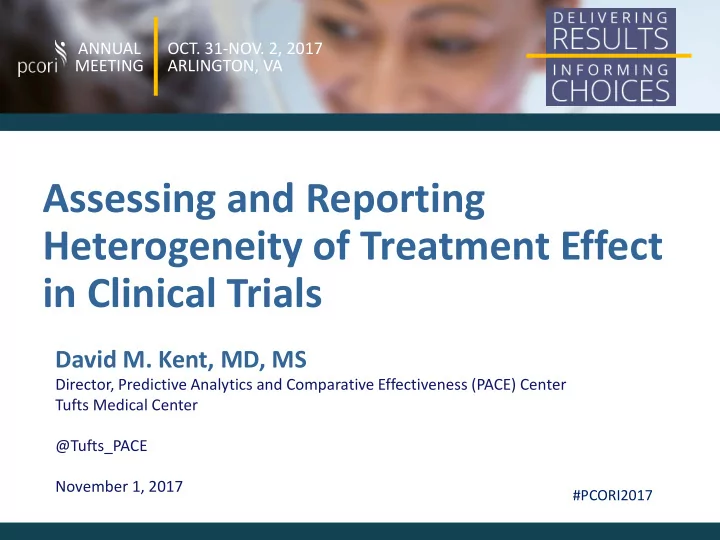

ANNUAL OCT. 31-NOV. 2, 2017 MEETING ARLINGTON, VA Assessing and Reporting Heterogeneity of Treatment Effect in Clinical Trials David M. Kent, MD, MS Director, Predictive Analytics and Comparative Effectiveness (PACE) Center Tufts Medical Center @Tufts_PACE November 1, 2017 #PCORI2017
ANNUAL MEETING | #PCORI2017 Background • Person-level heterogeneity of treatment effects (HTE) is ubiquitous. • Group-level HTE is rarely reliably identifiable in clinical trials. 2
ANNUAL MEETING | #PCORI2017 Problems with conventional subgroup analysis • Patients have too many attributes • Low power 3
ANNUAL MEETING | #PCORI2017 Why privilege risk-based HTE analysis? • Risk is a known mathematical determinant of treatment effect. 4
ANNUAL MEETING | #PCORI2017 Common measures of treatment effect Risk Reduction Definition (RR) Absolute RR EER-CER Relative RR 1 - EER CER Odds Ratio EER/(1-EER) CER/(1-CER) CER=control event rate EER=experimental event rate 5
ANNUAL MEETING | #PCORI2017 Why privilege risk-based HTE analysis? • Risk is a known mathematical determinant of treatment effect. • When baseline risk heterogeneity is present (and the treatment effect is non-zero), there is always HTE. • Risk provides a summary measure that takes into account multiple variables that are relevant and provides “patient-centered” evidence. 6
Kent DM, et al. J Gen Intern Med 2002; 17:887-94. 7
Kent DM, et al. J Gen Intern Med 2002; 17:887-94. 8
16.3% 1.0% Kent DM, et al. J Gen Intern Med 2002; 17:887-94.
ANNUAL MEETING | #PCORI2017 DANAMI-2 High Risk Low Risk 10 Thune JJ, et al. Circulation 2005,112:2017-2021.
ANNUAL MEETING | #PCORI2017 Predicted risk distributions in RCTs 11 Kent DM et al. Int J Epidemiol. 2016 Jul 3. pii: dyw118.
ANNUAL MEETING | #PCORI2017 Relative risk reduction across risk quartiles • Treatment effect heterogeneity on the proportional scale across patients at different baseline risk was rare. 12
ANNUAL MEETING | #PCORI2017 Absolute risk reduction across risk quartiles Substantial differences in • absolute treatment effects were common. Displaying results across • subgroups defined by risk is feasible and can lead to clinically important findings. 13
ANNUAL MEETING | #PCORI2017 Diabetes Prevention Program (DPP) Randomized Controlled Trial • Participants : 3060 non-diabetic persons with evidence of impaired glucose metabolism • Intervention: Intervention groups received metformin or a lifestyle-modification program • Main outcome measure : Development of diabetes The DPP study was conducted by the DPP Investigators and supported by the National Institute of Diabetes and Digestive and Kidney Diseases (NIDDK). 14
ANNUAL MEETING | #PCORI2017 DPP Risk Stratified Results: Hazard Ratios p-value = not statistically significant p-value = 0.0008 15 15
ANNUAL MEETING | #PCORI2017 DPP Risk Stratified Results: Absolute Risk 16
ANNUAL MEETING | #PCORI2017 Improving Diabetes Prevention with Benefit- Based Tailored Treatment • Making the risk model available at the point of care - Stakeholder partners: - AMGA (formerly American Medical Group Association) - Project teams: - Mercy (St. Louis) – 3,000 providers - Premier Medical Associates (Pittsburgh) – 100 provider s • Incorporating EHR-compatible model - Epic (Mercy) - Allscripts (Premier) 17
ANNUAL MEETING | #PCORI2017 Redevelopment of DPP risk model in EHR • Model developed and geographically validated in OptumLabs • Risk factors: age, gender, race, ethnicity, height, BMI, smoking status, hypertension, A1c, FPG, triglycerides, HDL, SBP validation development n = 1,075,833 n = 1,076,983 c-statistic = c-statistic = 0.735 0.763 E = 1.48% E = 0.92% E90 = 1.73% E90 = 2.25% 18
ANNUAL MEETING | #PCORI2017 19
ANNUAL MEETING | #PCORI2017 Questions? 20
ANNUAL MEETING | #PCORI2017 Thank You! David M Kent, MD, MS Director, Predictive Analytics and Comparative Effectiveness (PACE) Center Tufts Medical Center @Tufts_PACE November 1, 2017 21
ANNUAL MEETING | #PCORI2017 Learn More • www.pcori.org • info@pcori.org • #PCORI2017 22
Recommend
More recommend